Ready to take hamburger to a whole new level? Try tender and juicy Nikomi Hambagu or Japanese Stewed Hamburger Steak. We first sear the patties, then simmer them gently in a bold and savory wine-reduction sauce. Top it with cheese for a layer of melty goodness!
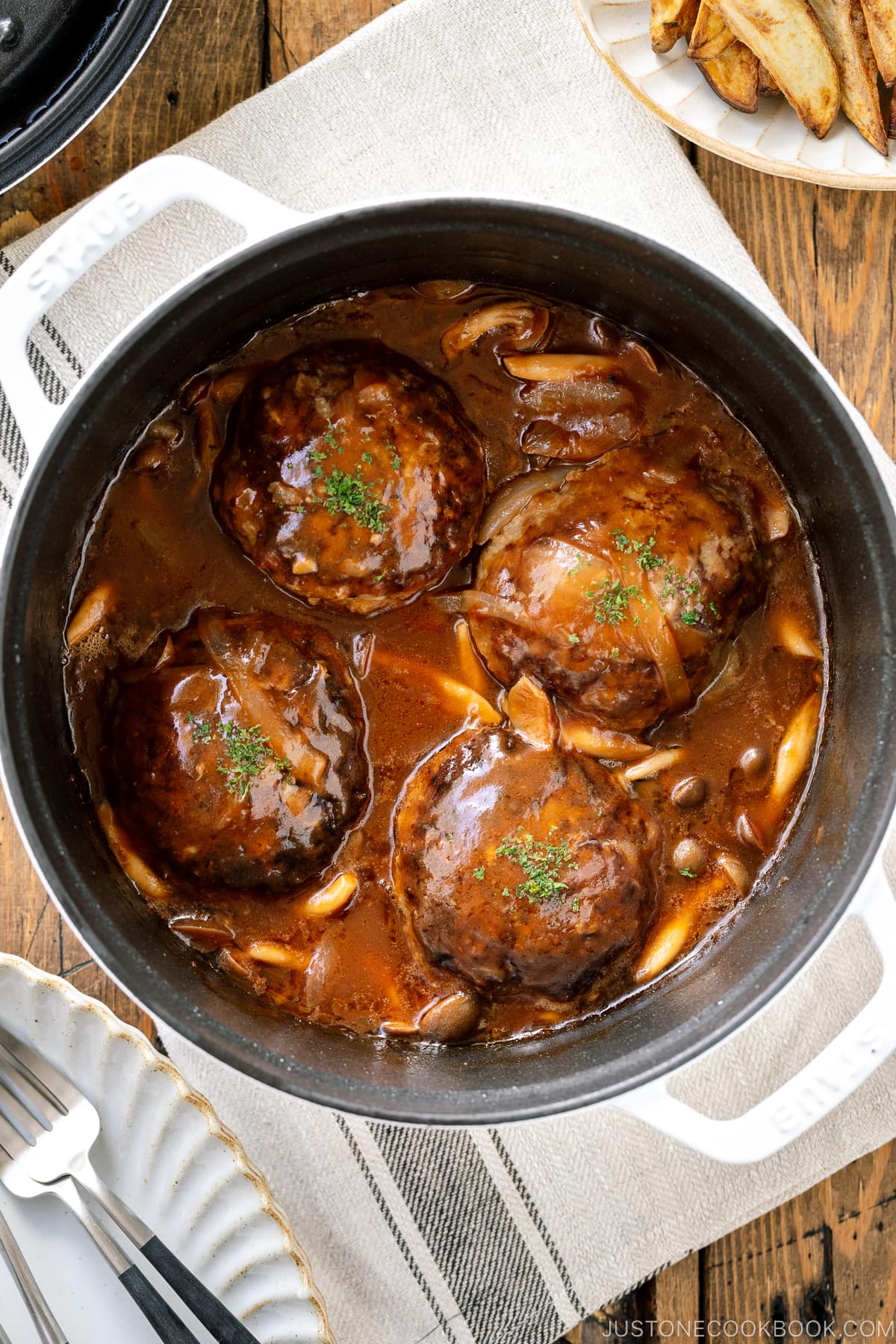
Besides the traditional Japanese cuisine known as washoku, we also enjoy various western-influenced food called yoshoku. It is a big part of Japanese food culture that has influenced the way we eat and cook at home. Today, I’m sharing one of my son’s favorites, Japanese Stewed Hamburger Steak or Nikomi Hambagu (煮込みハンバーグ).
What is Nikomi Hambagu
First, let’s talk about hambāgu (ハンバーグ) or Japanese Hamburger Steak (ハンバーグステーキ). It’s a popular dish enjoyed at home and at yoshoku (Japanese-style western food) restaurants.
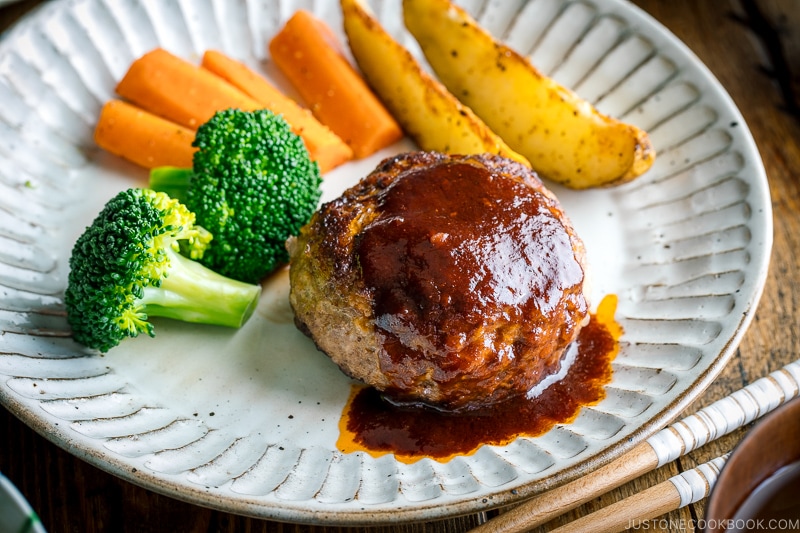
Hambagu is a steak made from ground meat—typically both beef and pork—and served with rice rather than buns. The hambagu steak comes with a delicious gravy-like sauce made with ketchup and Worcestershire sauce.
Nikomi Hambagu (煮込みハンバーグ) is the hambāgu that’s simmered (in Japanese, the word is nikomu) in the sauce. After searing the patties, they are cooked in the savory wine-reduction sauce until the patties are fully cooked through and absorb all the flavors from the sauce.
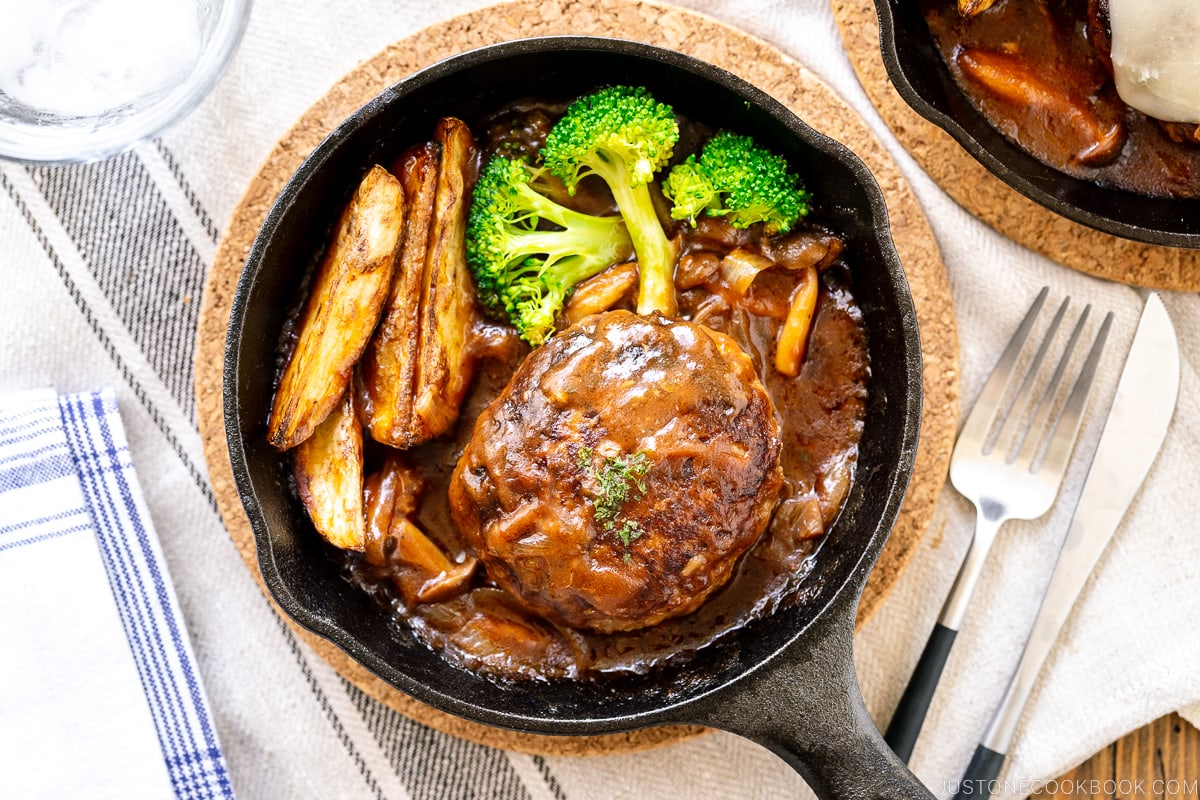
Restaurants usually make demi-glace sauce from scratch, using vegetables and flavorful stock. However, at home, we would make a quick sauce with common condiments like ketchup, Worcestershire sauce, and wine.
Why You Should Make This Recipe
- So delicious and comforting, perfect weekend recipe!
- A big step up in terms of flavors and cooking technique.
- You can make nikomi hambagu ahead of time (unlike regular hambagu).
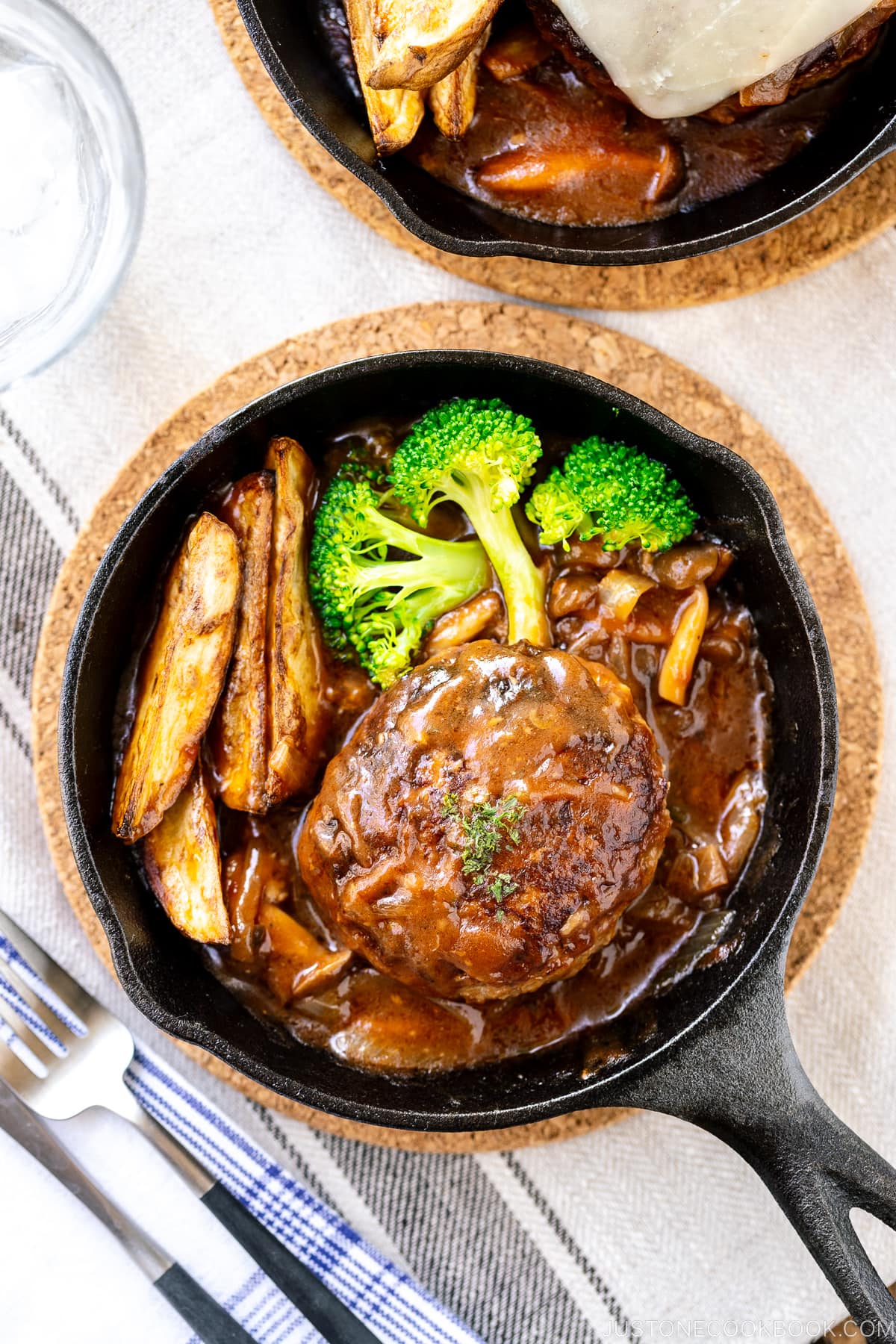
How to Make Japanese Stewed Hamburger Steak
Ingredients You’ll Need
- A combination of ground beef and ground pork (Aibiki Niku – learn more in Tips)*
- Onion
- Egg
- Panko
- Milk
- Seasonings: nutmeg, salt, pepper, butter
- Shimeji mushrooms (or other mushrooms)
- Hambagu Sauce: Chicken stock, wine, ketchup, Worcestershire sauce, sugar, butter, flour, bay leaf
- Cheese (optional)
Overview: Cooking Steps
- To make the hambagu patties: Sauté the onions, mix all the patty ingredients, make the mixture into 4 patties, and refrigerate.
- Cook the patties until both sides are nicely seared.
- To cook the hambagu sauce: Cook the onion and mushrooms and make the hambagu sauce.
- Put the patties into the sauce and let it simmer for 15-20 minutes.
- Optionally, put the cheese on top to melt. Serve with steamed broccoli and baked potato fries.
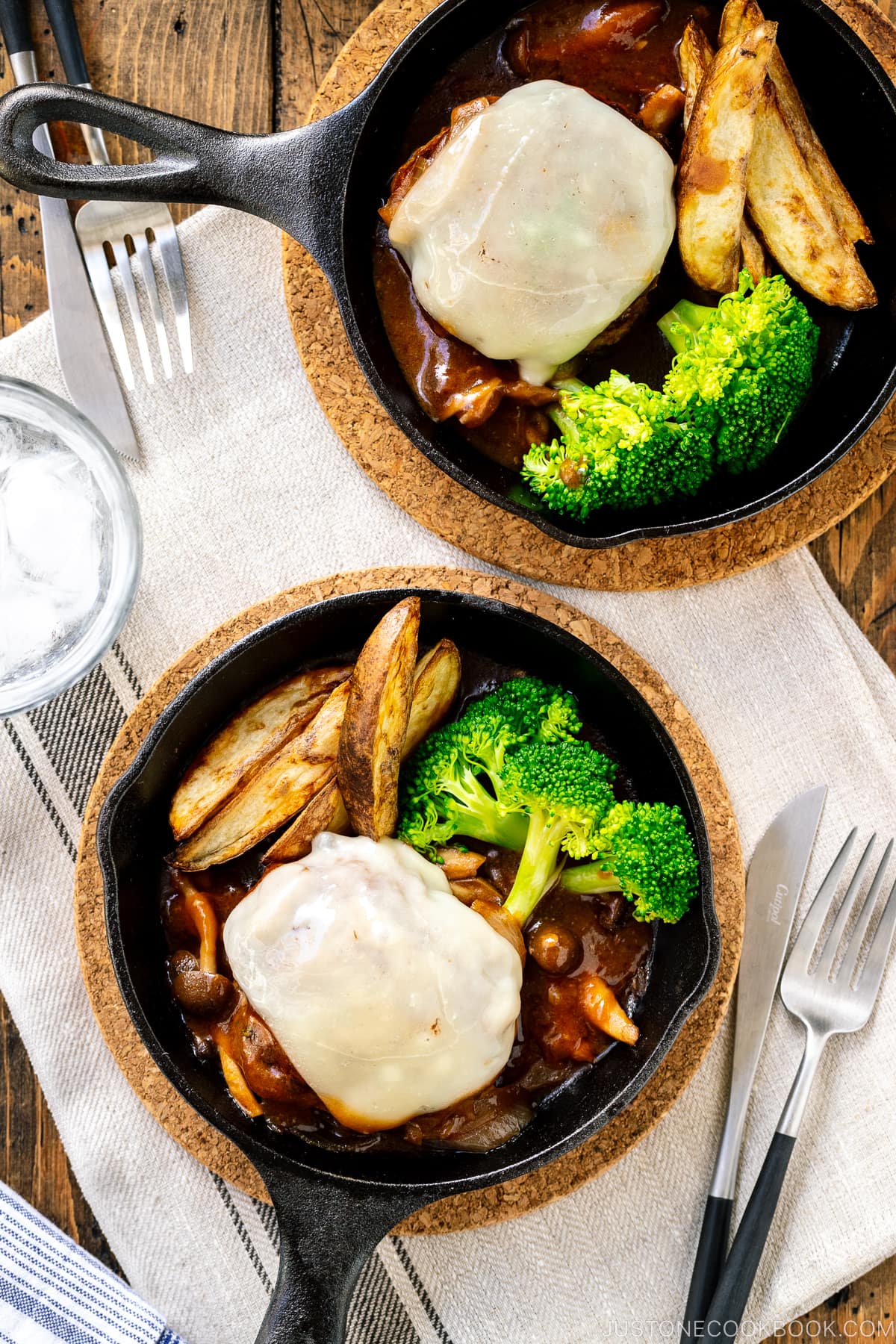
5 Cooking Tips to Make the Best Hambagu
Tip 1: Use a beef and pork combo.
Hambāgu in Japan is typically made from both ground beef and ground pork, and this mixed ground meat is called aibiki niku (合いびき肉). The common ratio of aibiki niku is 7:3.
Originally, beef was expensive so pork was mixed in to increase the bulk. However, over time, we learned that aibiki niku is scientifically superior to making hambāgu and other recipes like Menchi Katsu, Spaghetti Meat Sauce, and Curry Doria (Rice Gratin). The fat contained in pork has a low melting point, just about the body temperature of a human being. On the other hand, the melting point of beef fat is higher than that, By combining the beef and pork together, the fat melts in the mouth even when the meat cools down slightly, making it delicious to eat.
Supermarkets in Japan sell a convenient package of both ground beef and ground pork so that we don’t have to buy the meat separately. For this hambagu recipe, you can decide the beef/pork ratio of either 2:1 (8 oz/4 oz) or 3:1 (9 oz/3 oz).
Tip 2: Knead the meat mixture well.
Knead the mixture with your hand until it’s pale and sticky.
Tip 3: Playing catch with the meat mixture
Play catch, tossing meat mixture from your left hand to your right hand. Do this a couple of times in order to release the air inside. If you skip it, the meat patties will crack while cooking.
Tip 4: Chill the patties in the fridge
Let the meat patties cool in the refrigerator for 20-30 minutes to solidify fats on the surface and take them out right before cooking.
Tip 5: Make an indentation on the patties
Indent the center of each patty with 2-3 fingertips. While cooking, the air inside the patties heats up and expands, causing the center of the patties to swell. The indentation will disappear as the meat swells.
If you don’t make the indentation, the patties will swell and you may end up pressing down the swelled patties, losing delicious juice coming out from the inside. The meat patties could possibly expand and crack.
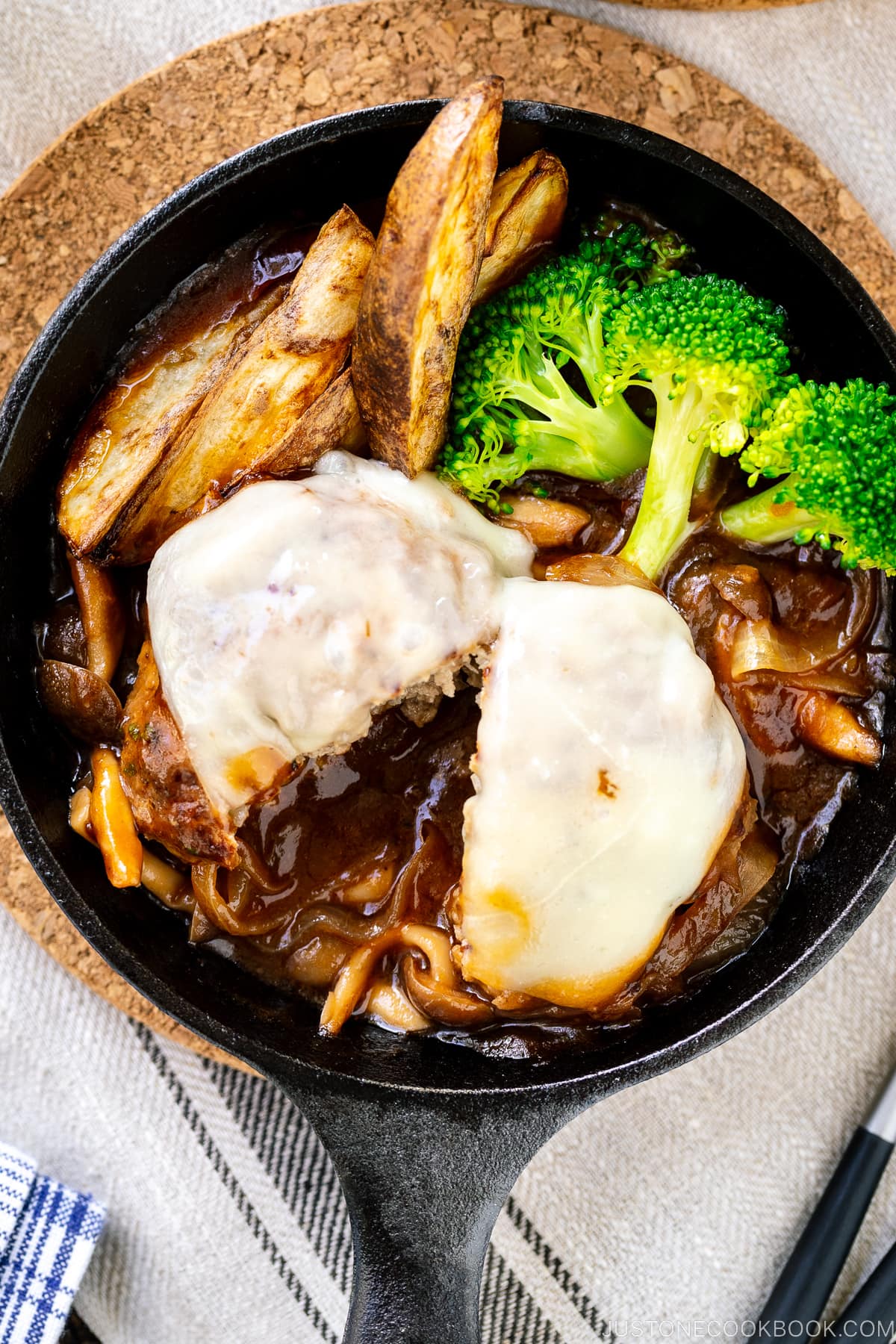
How to Make the Delicious Hambagu Sauce
The sauce the patties are stewed in is a demi-glace sauce. Demi-glace is a rich brown sauce in French cuisine made with beef bone, onions, celery, tomatoes, carrots, red wine, and brown roux. In Japan, we use demi-glace sauce for many western-style yoshoku dishes such as Hayashi Rice, beef stew, and Omurice. The sauce does take a long time to make from scratch, but in Japan, you can easily buy canned demi-glace sauce from regular grocery stores.
In the US, you can find canned demi-glace sauce at Japanese grocery stores or on Amazon, but it’s also possible to make it at home.
For this recipe, I make the sauce using commonly available condiments and it turns out just as good considering it’s a shortcut version.
When making the sauce, there are some important cooking tips you should follow:
- Sauté the onion until tender and translucent. The onions get sweeter as you cook. Take advantage of the natural sweetness of the ingredient.
- Cook the flour on a gentle heat. No one likes tasting raw flour. Take your time to cook the flour on low heat.
- Gradually add chicken stock while you mix and incorporate the flour mixture into the stock. It’s very important to slowly add the stock for a lump-free sauce.
- Let the alcohol from the wine evaporate, if you don’t like the alcohol taste or if you serve it for children. Most of the alcohol will be evaporated while cooking.
- Taste the sauce to adjust the flavor. Remember, every ketchup and chicken stock brand varies in taste. Some are sweeter or saltier than others. So you have to taste your own sauce and adjust to your liking.
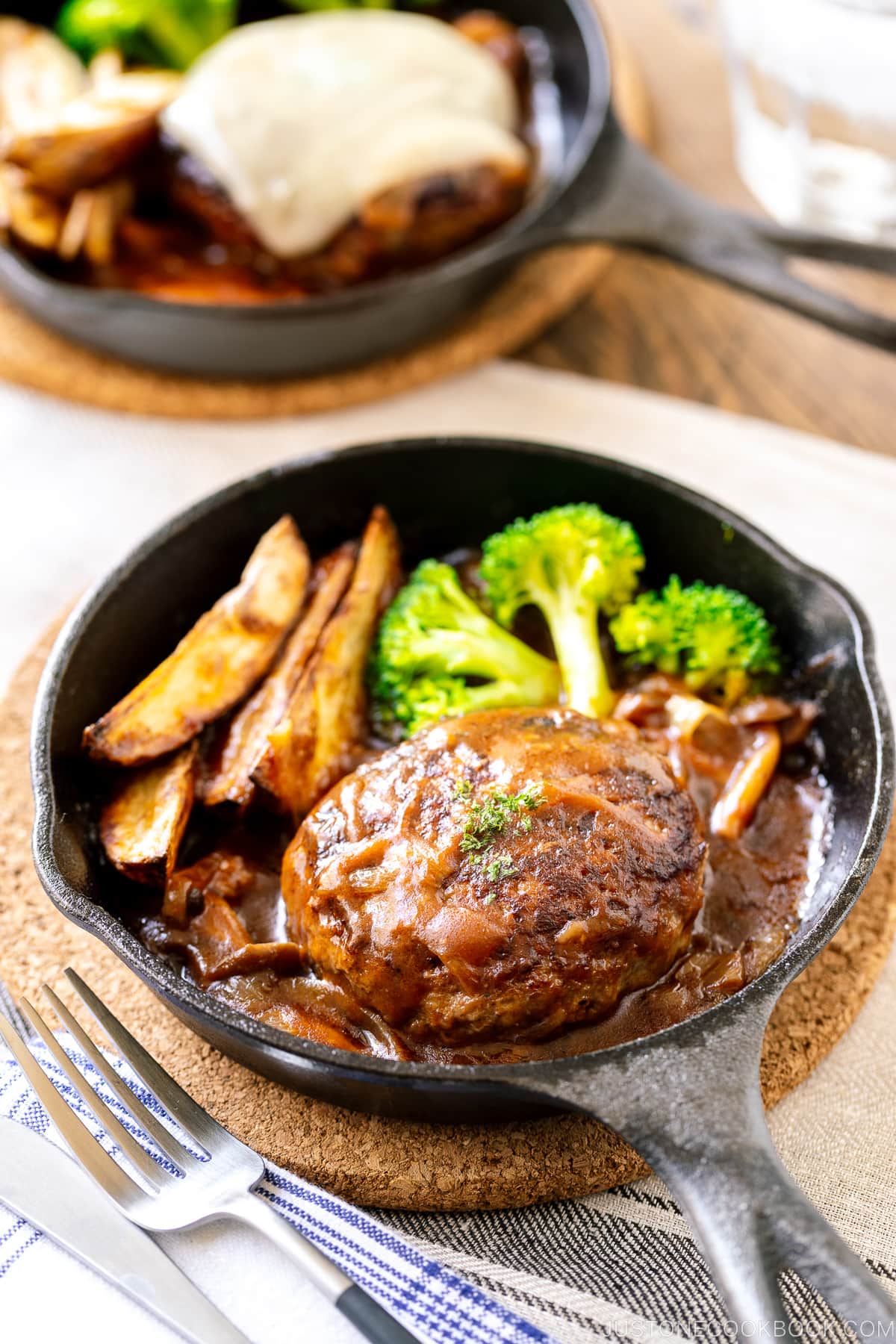
What to Serve with Stewed Hamburger Steak
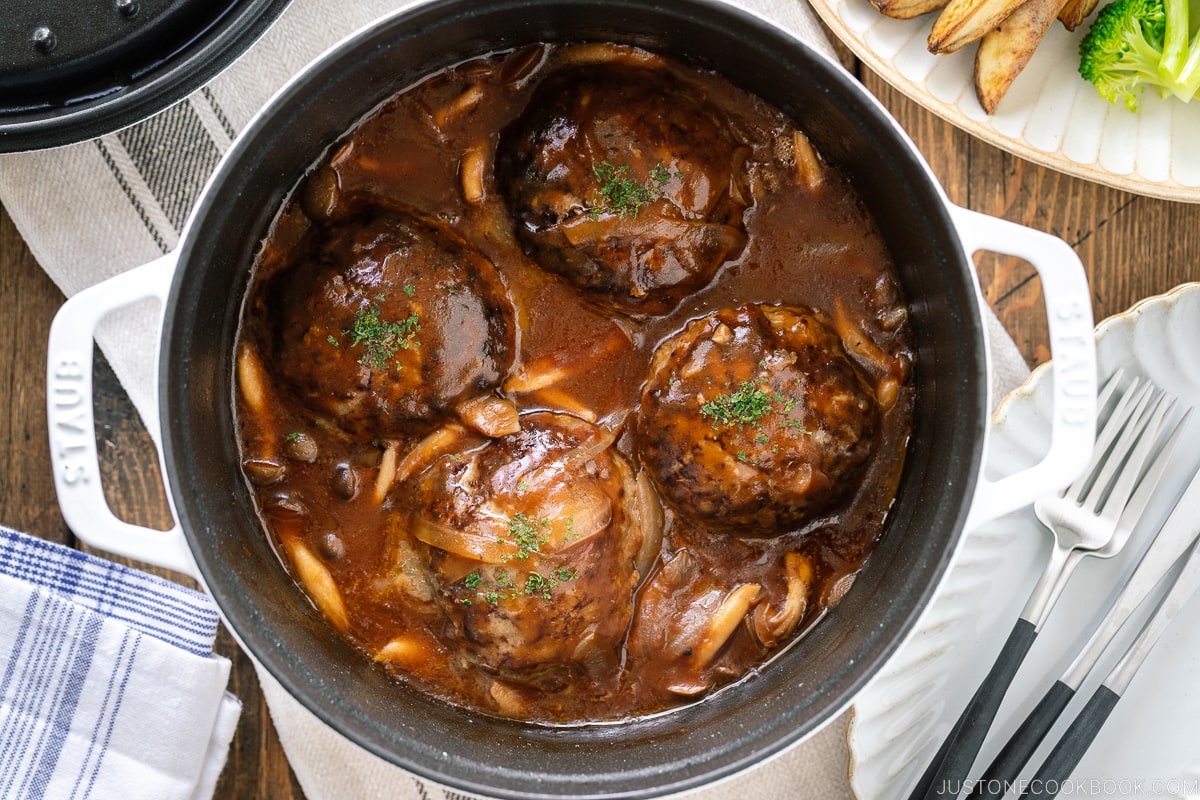
Wish to learn more about Japanese cooking? Sign up for our free newsletter to receive cooking tips & recipe updates! And stay in touch with me on Facebook, Pinterest, YouTube, and Instagram.
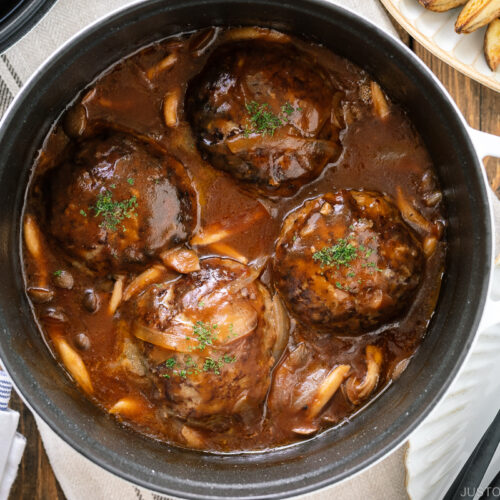
Japanese Stewed Hamburger Steak (Nikomi Hambagu)
Ready to take hamburger to a whole new level? Try tender and juicy Nikomi Hambagu or Japanese Stewed Hamburger Steak. We first sear the patties, then simmer them gently in a bold and savory wine-reduction sauce. Top it with cheese for a layer of melty goodness!
Ingredients
Prevent your screen from going dark
Instructions
To Prepare the Ingredients
-
Finely mince ½ onion for the hambagu patties. Lay the onion half flat side down on the cutting board. With the knife tip pointing toward the root end, make ⅛-inch vertical slices to within ½ inch of the root end. Then, with the knife edge toward the root end, make ⅛-inch horizontal slices, again keeping the root intact.
-
Finally, make perpendicular cuts down through the vertical slices you made. If you need to chop the onions finer, run your knife through them using a rocking motion. Be sure to hold down the tip of the knife; otherwise, the onions will go flying around the room. Set aside.
-
Thinly slice ½ onion for the hambagu sauce. Set aside.
-
Cut off and discard the bottom of 1 package shimeji mushrooms and separate them into small clusters. Set aside for the hambagu sauce.
To Sauté the Minced Onion for the Patties
-
Heat a large frying pan over medium heat. Add 1 Tbsp unsalted butter while the pan is heating up and distribute it evenly. Don‘t burn the butter. Add the minced onion to the pan.
-
Sauté the minced onion until golden brown and translucent.
-
When the onions are done cooking, transfer to a large bowl and let cool.
To Shape the Patties
-
To the sautéed minced onions, add ¾ lb ground beef and pork combination, ½ tsp Diamond Crystal kosher salt, ⅛ tsp freshly ground black pepper, ½ tsp nutmeg, ⅓ cup panko (Japanese breadcrumbs), 1 large egg (50 g each w/o shell), and 2 Tbsp milk.
-
Using a silicone spatula or your hand, mix it all together until well combined. Then, knead the mixture, in a circular motion, until it gets sticky and becomes pale in color. Your arm may get tired, but it‘s a very important step to meld the ground meats together.
-
Divide the mixture into quarters and scoop one portion into your hand.
-
Toss it from one hand to the other repeatedly about five times in order to release any air inside the mixture (see the video link above). Tip: Without releasing the air inside, the hamburger steaks will likely crack while cooking.
-
Make an oval-shaped patty and place it on a tray or plate. Repeat with the remaining portions. Cover the patties with plastic wrap and refrigerate them for at least 20–30 minutes before cooking so that the flavors of the meat further meld together and the fat solidifies.
To Make the Sauce
-
While the hambagu patties are resting, make the sauce. On the stove over medium heat, set a large pot (I used this 5.5-QT Staub cast iron pot) that fits 4 patties. When it‘s hot, add 1 Tbsp unsalted butter and 1 Tbsp neutral oil. Distribute them evenly and add the onion slices.
-
Using the blunt-end wooden spatula, sauté the onion slices until tender and translucent.
-
Add the shimeji mushrooms and toss to coat with the oil and butter. Cook until they become slightly tender.
-
Next, start making the roux: Turn the heat to low and sprinkle in 1 Tbsp all-purpose flour (plain flour). Cook the flour with the onions and mushrooms for 2–3 minutes, scraping the bottom of the pot constantly. It‘s important that you cook the flour gently during this step to get rid of its raw taste, but don‘t let it toast or turn dark. You want the pale color of a white roux. If it starts to brown, turn off the heat temporarily while you finish cooking it. Once it‘s done cooking, turn the heat to medium low.
-
Next, add about 1–2 Tbsp of ½ cup chicken stock/broth to the pot. Use your spatula to quickly and vigorously blend the stock well with the flour mixture. You will notice the flour absorb all the moisture and clump up.
-
Continue to add more stock, 1–2 Tbsp at a time, stirring quickly after each addition to combine it well with the flour and smooth out any clumps. Make sure there are no lumps of flour left when you‘re done adding all the stock. Your sauce base is now done.
-
Next, add ¼ cup red wine, ¼ cup ketchup, and ¼ cup Worcestershire sauce to the pot.
-
Add 1 bay leaf and 2 tsp sugar and mix well together. Increase the heat to medium and bring it to a gentle simmer. Once simmering, turn off the heat.
To Sear the Patties
-
Take out the hambagu patties from the refrigerator. Heat a large frying pan over medium heat. When it‘s hot, add 1 Tbsp neutral oil and distribute it evenly. Place the patties gently into the pan, spacing them an inch (2.5 cm) apart so you can easily insert the spatula to flip the patties later on.
-
Indent the center of each patty with 2–3 fingertips because the centers will rise with the heat. Cook the patties until browned on the bottom, about 3 minutes.
-
Then, carefully flip and cook the other side for another 3 minutes or until browned. Turn off the heat. Tip: The inside of the patties won‘t be cooked through yet. You‘ll finish cooking the hambagu in the sauce next.
To Cook the Nikomi Hambagu
-
Gently transfer the patties and their pan juices into the pot with the hambagu sauce.
-
Close the lid and bring it to a gentle simmer on medium heat. Once simmering, reduce the heat to medium low. Open the lid and spoon the sauce over the patties.
-
Close the lid again and simmer gently for 15 minutes. Occasionally uncover the pot to coat the patties with the sauce. You do not need to flip them. After 15 minutes of cooking, the Nikomi Hambagu is ready to serve.
To Serve
-
Serve the hambagu hot on individual plates along with the hambagu sauce. I typically serve the dish with oven-baked potato wedges, blanched broccoli, butter-sautéed carrots, or/and corn kernels. You can also bring the pot to the table to keep it hot. Here, I sprinkled them with dried parsley for color; you can use fresh chopped parsley as well.
To Serve the Nikomi Hambagu in Individual Mini Cast Iron Pans
Nutrition
Nutrition Facts
Japanese Stewed Hamburger Steak (Nikomi Hambagu)
Amount per Serving
% Daily Value*
* Percent Daily Values are based on a 2000 calorie diet.

